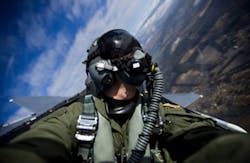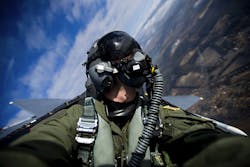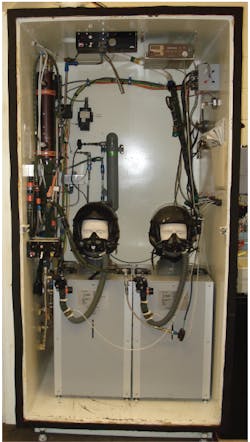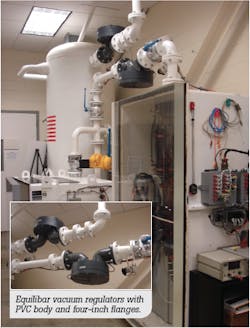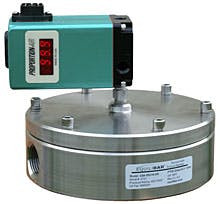The U.S. Navy’s Altitude Laboratory at the Naval Air Warfare Center (NAVAIR) is critical to the research, development, testing, and evaluation of safe and effective oxygen systems for military aircraft. The lab is capable of testing complete gaseous, liquid, and On-Board Oxygen-Generating Systems (OBOGS), as well as individual components of a life support system. Real-time data collection and mechanical breathing simulators allow testing at barometric altitudes up to 60,000 ft. The NAVAIR Altitude Laboratory has three hypobaric chambers of 6, 54, and 650 ft3 in volume, each separately controlled by LabView computerized vacuum systems.
The Challenge
Previously, the lab used traditional vacuum control valves to throttle flow between hypobaric chambers and large vacuum pumps. These valves used electro-pneumatic transducers and pneumatic actuators with mechanical linkages to swing-butterfly seats. Such mechanical systems are common throughout the industry, but are not capable of responding quickly enough to any perturbation in the pressure/flow balance, which frequently occurs in NAVAIR’s oxygen systems and mask testing.
Testing of oxygen-generating systems and components presents unique challenges due to the large perturbations created by the aircraft mechanical systems and sinusoidal breathing at high altitudes. The Altitude Laboratory found that a mechanical butterfly valve was not able to adjust to the sudden onset of such high volumetric flowrates. In fact, barometric pressure swings of 2,000 ft. to 4,000 ft. in altitude were observed in some hypobaric chambers.
An additional concern to NAVAIR was the mechanical wear on these linkages due to the cyclic action of controlling non-steady conditions.
Initial Attempt
An attempt was made to solve the problem by installing a dome-loaded pressure-reducing regulator to allow enough air pressure into the chamber to control the vacuum. The chamber pressure was monitored by a closed-loop controller that sent a signal to an electronic pressure regulator, which piloted the 1-to-1 dome-loaded vacuum relief regulator. However, because of their limited flow capability, and because the pressure-reducing regulators were designed for typical industrial pressure and precisions, the altitude chamber’s barometric pressure varied widely with abrupt changes in flowrate. The closed-loop control was not fast enough and lacked sufficient flow capacity to follow the rapid changes from the Pressure Swing Adsorption Oxygen Systems or mask breathing cycles.
RELATED: Calibration Consideration–An alternative approach for calibrating mass flow controllers
Solution
In 2011, NAVAIR initiated a Capital Improvement Program and contracted with Research, Engineering and Development, Inc. and Spectrum Sciences, Inc. to upgrade the performance and reliability of the lab’s altitude chambers. Spectrum engineer Curtis Stansfield contacted Equilibar after reading about its new approach to vacuum regulation using a supple diaphragm as the only moving part. Equilibar’s back-pressure and vacuum regulators provide stable pressure across flowrate changes of up to 1,000-to-1 and typically adjust to changes in flowrate in under 10 milliseconds.
Working with Stansfield and NAVAIR’s Dennis Gordge, Equilibar designed and provided three large PVC regulators sized for three-inch pipe systems. In addition, Equilibar’s design incorporated electro-pneumatic regulators from Proportion-Air with ultra-high resolution and virtually zero dead-band or hysteresis. These QPV electronic regulators perfectly complemented Equilibar’s vacuum regulators, also with virtually zero deadband or hysteresis.
The high-speed response required by this application was achieved using Equilibar vacuum regulators because they use not one valve orifice, but in this instance, over 100 parallel orifices. The lightweight, supple diaphragm has to move only a few millimeters to modulate the vacuum regulator from fully closed to fully open. The thin Viton diaphragm is sensitive to changes in pressure as small as 0.001 PSI.
Improvements in Stability & Accuracy
The new system provides a significant reduction in altitude pressure variation. Even with non-steady exhalation flows, the chamber altitude is maintained within +/-50 ft., an 85 percent reduction in variability. As Gordge explained, the new system with Equilibar regulators has dramatically improved precision. “We are now able to resolve simulated altitude to within +/- 10 ft. in some situations,” he said.
The pressures involved in this design underscore the uniquely difficult nature of the application. At 60,000-ft. altitude, the atmospheric pressure is roughly at 46 Torr (mm Hg absolute). A +/-50-foot elevation change would occur if the absolute pressure swing was from 46.476 Torr to 46.192 Torr. This equates to about 0.002 mm Hg vacuum per foot of altitude. Even in an open loop mode, relying only on the accuracy of the pilot pressure provided, the Equilibar vacuum regulators were able to hold within this margin of error.
Design Details
The NAVAIR LabView control software was implemented with open-loop control, meaning that the command voltage sent to the electronic pressure regulator is carefully calibrated to correlate with the resulting altitude. Because of the high level of repeatability of the QPV and Equliibar regulators, closed-loop feedback control is not required.
However, as the schematic suggests, the PLC control system could also use PID control to trim the signal to the QPV electronic pressure regulator to maintain the altimeter precisely at the desired setting.
Descent Control
As shown in the diagram below, an air bleed was incorporated to allow air into the system during descents, or reductions in elevation. Due to this application’s complexity, the NAVAIR system incorporated one bleed orifice and two separate solenoid valves with varying orifice sizes to provide for three different operational modes. First, a very small orifice was installed to allow a low constant bleed rate to improve performance and allow minor adjustments in altitude. Second, for controlled descents, a 0.25-inch orifice was installed.
Finally, a 0.5-inch larger orifice was installed to allow for rapid ingress of air to simulate a faster descent. Having all orifices open allowed for simulated emergency descent. The orifice size did not control the altitude pressure, nor did it control the rate of descent. The orifices were used simply to ensure that there was enough atmospheric air coming in to the system to allow the desired rate of change. In all modes, the actual rate of ascent and descent is controlled by the Equilibar vacuum regulator, working to pull air out of the chamber to balance the inflow of air through the automatic orifice bleeds.
The rate of descent was set by providing a ramping electronic command signal to the precision electronic pressure regulator. The electronic regulator faithfully reproduced the electronic ramp as a pneumatic pressure ramp in the pilot chamber of the Equilibar vacuum regulator, which in turn reflected the pilot pressure on its controlled inlet port. The rate of the pressure ramp by the PLC is what was used to control the rate of descent in the chamber.
Other Applications
While traditional butterfly valves work acceptably in most vacuum control situations, applications that are uniquely challenging and critical require a more specialized system. The system described here could be considered wherever rapid control reactions or highly precise control is required. The Proportion-Air QPV and the Equilibar vacuum regulator can work together in a variety of control scenarios to provide creative solutions where traditional control valves are not adequate.
Jeff Jennings, P.E., is founder and president of Equilibar, LLC, a provider of high precision pressure control solutions. Prior to Equilibar, he worked as a process development engineer for 23 years. He is a licensed professional engineer in North Carolina and holds several patents. Jennings can be reached at [email protected] or 828-650-6590.
About the Author
Jeff Jennings
Jeff Jennings, PE, is founder and president of Equilibar, an engineering company that specializes in precision fluid control for challenging applications around the world. Jennings has more than 30 years of engineering experience including 16 years with The DuPont Company. He holds several international patents and continues active research in the field of fluid controls. He may be reached at [email protected].
